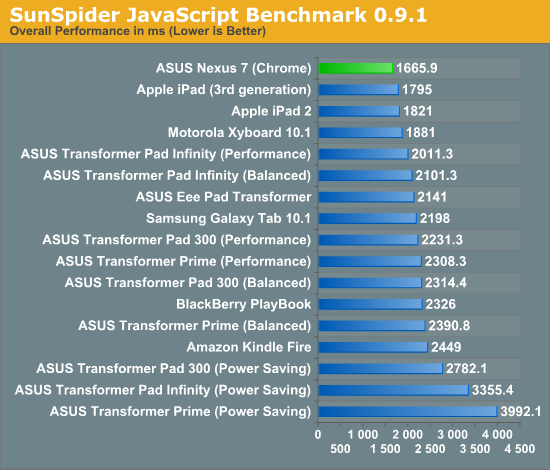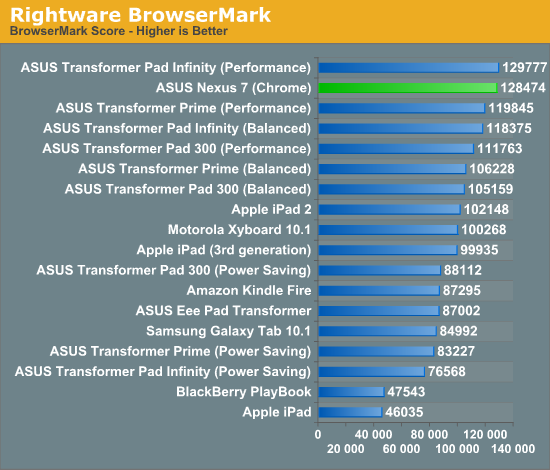The Google Nexus 7 Review
by Anand Lal Shimpi & Brian Klug on July 26, 2012 11:35 AM ESTThe SoC & Performance
While Amazon chose TI's OMAP 4 for the Kindle Fire, Google and ASUS picked arguably the second best SoC on the market today: NVIDIA's Tegra 3. Keep in mind that high-end ARM SoCs generally sell in the $14 - $25 range per chip, which a fabless semiconductor manufacturer has to split with a foundry. The result is a far cry from the margins NVIDIA is used to making on high-end discrete GPUs. I suspect a desire to make good use of all functional Tegra 3 parts that come back from the fab is the reason why we have so many variants of the Tegra 3.
To date we've seen three Tegra 3 SKUs used in tablets: T30L, T30 and T33. Factor in the smartphone SKUs (AP30, AP33) and it's already a pretty healthy collection for a single chip. The main differences between the 30L, 30 and 33 parts are voltages and clock speeds. I've shown this table in previous articles but I present it here again since T30L is what's in the Nexus 7:
| NVIDIA Tegra 3 | |||||||
| CPU Cores | Max CPU Clock (1 core active) | Max CPU Clock (multiple cores) | GPU Cores | Max GPU Clock | |||
| NVIDIA Tegra 3 (T33) | 4+1 | 1.7GHz | 1.6GHz | 12 | 520MHz | ||
| NVIDIA Tegra 3 (T30) | 4+1 | 1.4GHz | 1.3GHz | 12 | 520MHz | ||
| NVIDIA Tegra 3 (T30L) | 4+1 | 1.3GHz | 1.2GHz | 12 | 416MHz | ||
The loss in performance compared to T30/T33 is marginal at best, at least for most consumer use cases. Four Cortex A9s running at up to 1.3GHz is definitely quick enough for the types of applications you'll run on the Nexus 7. Things can always be faster, but like the Kindle Fire's OMAP 4, the Nexus 7's T30L is good enough for now. Give it another year and we'll see something even faster at this price point. That's the downside of buying anything in the tablet/smartphone space these days unfortunately.
| ASUS Android Tablet Memory Choices | ||||||
| TF Prime | TF Pad 300 | Nexus 7 | TF Pad Infinity | |||
| Memory Capacity | 1GB | 1GB | 1GB | 1GB | ||
| Memory Type | DDR2-1000 | DDR3L-1333 | DDR3L-1333 | DDR3-1600 | ||
| Memory Bandwidth | 4.0GB/s | 5.3GB/s | 5.3GB/s | 6.4GB/s | ||
ASUS selected 1GB of DDR3L-1333 memory for the Nexus 7. This gives it more memory bandwidth than any of the Transformer series of tablets, with the exception of the Transformer Pad Infinity. Since the Tegra 3 SoC only has a single channel memory interface, ASUS had to rely on higher frequency memory to deliver sufficient bandwidth.
Note that the browser performance tests below paint a very good picture for the Nexus 7's performance because Android 4.1 replaces the default web browser with Chrome, with a much faster javascript engine.













118 Comments
View All Comments
Sined - Thursday, July 26, 2012 - link
Hey Anand, great review as usual.I want to point out something about the lack of an SDcard slot.
Dan Morrill from Google Android team explained on Reddit why Google is moving away from SDCard storage on Nexus Devices.
It's a really interesting read on the reasons why.
http://www.androidpolice.com/2011/11/18/impromptu-...
Lucian Armasu - Thursday, July 26, 2012 - link
You keep putting Windows RT together with Windows 8, as if they are the same thing and will be just as successful (or will fail just as much). But in what way is a Windows RT tablet, especially one that is twice as expensive, or at least as expensive as an iPad, better than an Android tablet? Is there an advantage at all that they hold over Android tablets? Because I see none, and I'm not sure why you keep up-playing Windows RT while downplaying Android tablet throughout your article.antef - Thursday, July 26, 2012 - link
Agreed....a hybrid x86 Win8 device might appeal to some people, but a WinRT ARM tablet is not inherently better than Android. I would actually argue Android is better because its app ecosystem is more mature and all the Google services apps are a given. Metro is completely unproven.WinRT will have the limited desktop with a simplified set of Office apps, that's it. I don't care about that at all, along with many other people I'm sure.
Impulses - Friday, July 27, 2012 - link
Office RT is the only clear advantage out of the gate, if they actually provide a featured desktop conversion that just happens to run on ARM... If all they put out is a Metro stepchild then that goes out the window. (no pun intended) It's a big selling point tho, but only if Win RT tablets are price competitive with iPads and Android tablets.Personally I'm still not sold on this holy grail of device convergence either way. 12" or smaller laptops are too cramped for serious work, and tablets just aren't as comfortable for use around the house at that size either. 7" or 8.9" is ideal IMO, specially as an addition to a 13"-14" laptop which is probably the most common scenario.
I say that despite having enjoyed using a 10" ASUS Transformer for over a year now. Currently I have that and a 3 year old netbook and I'm really yearning for a larger laptop replacement for the latter and a smaller tablet in the long run (the TF + dock has been a nice replacement for the netbook when traveling without work duties tho).
EnzoFX - Thursday, July 26, 2012 - link
Why will Win8 Tablets cannibalize Android tablets?I'm all for more competition, and MS is definitely bringing it, but are you implying it'll overtake Android right away? MS has a long way to go before that. Even their specs seems underpar, except for the intel powered one, which comes in at ultrabook pricing...
Impulses - Friday, July 27, 2012 - link
If that... I seriously don't see how Intel powered tablet hybrids will come in at ultrabook pricing all the while sporting better displays and near identical hardware all around (with a more complex builds). Something's gotta give, or the build quality of ultrabooks has inflated prices a ton...TareX - Friday, August 3, 2012 - link
Windows 8 RT is DOA. No apps, no way to compete, and it's too late in the game to start a new third party base. Windows 8 pro tablets are GREAT, except that they won't be price anywhere close to being competitive, so those are kind of DOA too in a different way. Very few people would pay $800-1000 for a tablet.Death666Angel - Thursday, July 26, 2012 - link
Thanks for the video review, I started missing them already! :DIf the Nexus had an SD slot and more storage out of the box without a 50USD increase in cost, I'd probably already have one. As it stands now, I'm content with my Chinese tablet (Cube U30GT). It has issues, but for the price (260€) it is pretty great. And I'm 100% with you, paying too much for tablets right now is not a smart move, considering the rapidity of the hardware development.
TareX - Friday, August 3, 2012 - link
You do realize this pricing is actually super generous on Google's behalf (they're selling it at a loss), yet you want them to include a MicroSD, and have more storage without the $50 bump. I'm all for a MicroSD but you're getting a wee bit too greedy here. There's a reason it's out of stock almost everywhere.Mr. Context - Thursday, July 26, 2012 - link
Hey, I think the biggest differences between the devices is in their aspect ratio and he HDMI output. Please check this link to hear my 50 cents on it... http://bit.ly/OezNK7